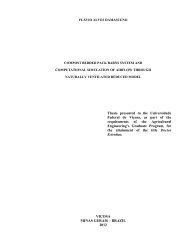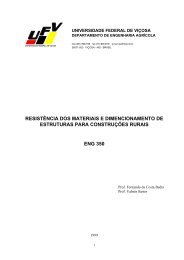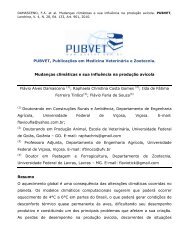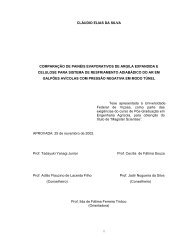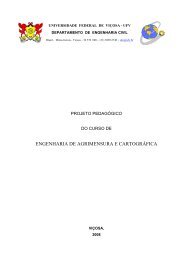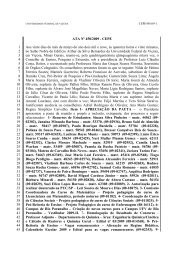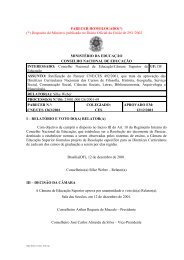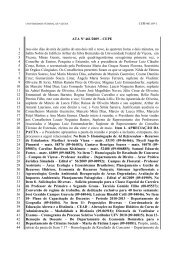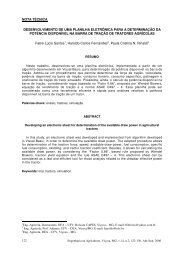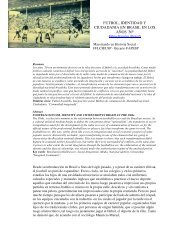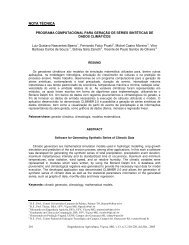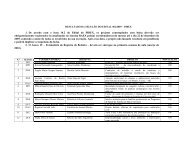ALKALOID BIOSYNTHESIS IN PLANTS: Biochemistry, Cell ... - UFV
ALKALOID BIOSYNTHESIS IN PLANTS: Biochemistry, Cell ... - UFV
ALKALOID BIOSYNTHESIS IN PLANTS: Biochemistry, Cell ... - UFV
You also want an ePaper? Increase the reach of your titles
YUMPU automatically turns print PDFs into web optimized ePapers that Google loves.
<strong>ALKALOID</strong> <strong>BIOSYNTHESIS</strong> <strong>IN</strong> <strong>PLANTS</strong> 43<br />
scopolamine by 6β-hydroxylation of the tropane ring followed by intramolecular<br />
epoxide formation via removal of the 7β-hydrogen (Figure 3). Cloning and heterologous<br />
expression of the H6H cDNA from Hyoscyamus niger showed that both<br />
reactions are catalyzed by a 2-oxoglutarate-dependent dioxygenase, hyoscyamine<br />
6β-hydroxylase (H6H; 101).<br />
Purine Alkaloids<br />
Purine alkaloids such as caffeine, theobromine, and theacrine are widely distributed<br />
in the plant kingdom. Recent metabolic studies in tea and coffee have elucidated<br />
the biosynthesis of caffeine. The major route begins with xanthosine and proceeds<br />
through three N-methylations via 7-methylxanthosine, 7-methylxanthine, and<br />
theobromine (5, 6, 169), although a number of minor pathways have also been suggested<br />
(78, 152). The pathway contains three SAM-dependent N-methyltransferase<br />
activities found in young tea leaves, but absent in fully developed leaves (50).<br />
A partially purified enzyme preparation exhibited three activities, suggesting either<br />
that the N-methyltransferase steps in caffeine biosynthesis are catalyzed by<br />
a single enzyme, or by multiple enzymes with similar properties (78). However,<br />
an N-methyltransferase purified from the endosperm and leaves of coffee<br />
was active only toward 7-methylxanthine and theobromine (102). Moreover, an<br />
N-methyltransferase that catalyzes the methylation of methylxanthines and designated<br />
caffeine synthase (CS) was purified from young tea leaves (79). CS catalyzes<br />
two consecutive methylations involved in the conversion of 7-methylxanthine<br />
to caffeine, but is inactive toward xanthosine, indicating that the first methylation<br />
is catalyzed by a different enzyme. A CS cDNA has recently been isolated<br />
and expressed in E. coli (H Ashihara, personal communication). The predicted<br />
amino acid sequence shows that CS shares greater homology to salicylic acid Omethyltransferase<br />
than to other N-, O-, and S-methyltransferases, suggesting that<br />
CS belongs to a new methyltransferase class.<br />
Subcellular Compartmentation of Alkaloid<br />
Biosynthetic Enzymes<br />
Many alkaloid biosynthetic enzymes occur in subcellular compartments other<br />
than the cytosol. The compartmentation of these enzymes effectively sequesters<br />
toxic alkaloids and their biosynthetic intermediates away from the cytosol. The<br />
subcellular trafficking of pathway intermediates also creates an important level<br />
of metabolic regulation that could not occur if enzymes and substrates diffused<br />
freely in the cytosol. An understanding of the subcellular compartmentation of<br />
alkaloid pathways will reveal whether various enzyme characteristics observed in<br />
vitro, such as their inhibition by pathway intermediates, represent a true regulatory<br />
function in vivo.<br />
Enzymes involved in vindoline biosynthesis have been localized to no fewer<br />
than five subcellular compartments. The conversion of tryptophan to tryptamine<br />
by TDC occurs in the cytosol (29, 162). Since STR is localized in the vacuole,



